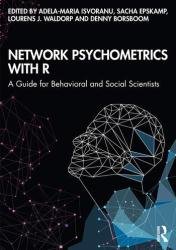Network Psychometrics with R: A Guide for Behavioral and Social Scientists
- Добавил: literator
- Дата: 12-01-2023, 06:46
- Комментариев: 0
 Название: Network Psychometrics with R: A Guide for Behavioral and Social Scientists
Название: Network Psychometrics with R: A Guide for Behavioral and Social ScientistsАвтор: Adela-Maria Isvoranu, Sacha Epskamp, Lourens Waldorp, Denny Borsboom
Издательство: Routledge
Год: 2022
Страниц: 261
Язык: английский
Формат: pdf (true)
Размер: 10.1 MB
A systematic, innovative introduction to the field of network analysis, Network Psychometrics with R: A Guide for Behavioral and Social Scientists provides a comprehensive overview of and guide to both the theoretical foundations of network psychometrics as well as modelling techniques developed from this perspective.
Written by pioneers in the field, this textbook showcases cutting-edge methods in an easily accessible format, accompanied by problem sets and code. After working through this book, readers will be able to understand the theoretical foundations behind network modelling, infer network topology, and estimate network parameters from different sources of data. This book features an introduction on the statistical programming language R that guides readers on how to analyse network structures and their stability using R. While Network Psychometrics with R is written in the context of social and behavioral science, the methods introduced in this book are widely applicable to data sets from related fields of study. Additionally, while the text is written in a non-technical manner, technical content is highlighted in textboxes for the interested reader.
Network models are statistical structures that characterize a multivariate probability distribution as a network. In a network model, nodes represent variables and links between nodes represent statistical relations between these variables. Note that variables are typically abstract entities, not concrete things, and statistical relations are estimated, not observed. In this sense, network models as used in the approach covered in this book are different from, for instance, social networks in which network nodes represent concrete individuals and relations between individuals are typically observable (or treated as such).
Using R for psychometric analyses is no longer reserved for specialists or extremely enthusiastic methodologists. During the past decade, psychometric analyses in R have expansively increased, making it, currently, the norm for doing general psychometric analyses. There are good reasons for this: R is a powerful programming language for statistical analyses, data visualization, data mining, and general programming. Furthermore, R is freely available, open source, and is accompanied by a large and lively community. Many statistical analyses, such as the ones discussed in this book, are implemented in R packages, making the use of novel statistical methods easy.
We suggest installing two different programs for using R: the base program R itself, as well as an integrated development environment (IDE): RStudio. R is the base programming language, which can be operated through the terminal or command prompt. The popular IDE RStudio presents a clear and easy-to-use environment to work in, which includes in addition to the R console itself also a plain text editor for editing R code, several useful panes for displaying plots, help files, loaded objects, and more. While it is possible to carry out all analyses presented in this book without using RStudio (e.g., by directly working in the computer terminal), we suggest using RStudio and assume it is used throughout this book.
Network Psychometrics with R is ideal for instructors and students of undergraduate and graduate level courses and workshops in the field of network psychometrics as well as established researchers looking to master new methods.
This textbook is organized into four broad parts:
I. Network Science in R. The first part provides the basic knowledge needed to understand and work through the remainder of this book. This includes theoretical foundations of network analysis, the programming background and skills necessary to independently carry out the practical exercises and analyses in R, chapters to introduce descriptive analyses of network structures and the fundamentals of constructing and drawing networks using R, as well as basic statistical knowledge about independence and conditional independence as central concepts in the estimation of psychometric network models.
II. Estimating Undirected Network Models. The second part focuses on estimating undirected networks, usually from cross-sectional data. The chapters introduce the reader to the class of statistical models most commonly used to infer network structures (i.e., pairwise Markov random fields), to the multitude of existing estimation methods, network comparison, as well as post-hoc stability and accuracy checks.
III. Network Models for Longitudinal Data. The third part moves the focus from cross-sectional data sets to data sets of one or more people measured repeatedly over time. In addition to discussing ways to estimate (time-varying) network models from longitudinal data, the chapters extensively discuss the difference between within- and between-subject effects and the generalizability of results based on cross-sectional data.
IV. Theory and Causality. The last part concludes the book with network approaches that explicitly go beyond statistically descriptive analysis tools. Two such approaches are discussed. First causal models, which represent causal relations between variables in directed acyclic graphs, and second Ising models, which are based on symmetric interactions between variables.
Скачать Network Psychometrics with R: A Guide for Behavioral and Social Scientists
[related-news] [/related-news]
Внимание
Уважаемый посетитель, Вы зашли на сайт как незарегистрированный пользователь.
Мы рекомендуем Вам зарегистрироваться либо войти на сайт под своим именем.
Уважаемый посетитель, Вы зашли на сайт как незарегистрированный пользователь.
Мы рекомендуем Вам зарегистрироваться либо войти на сайт под своим именем.
